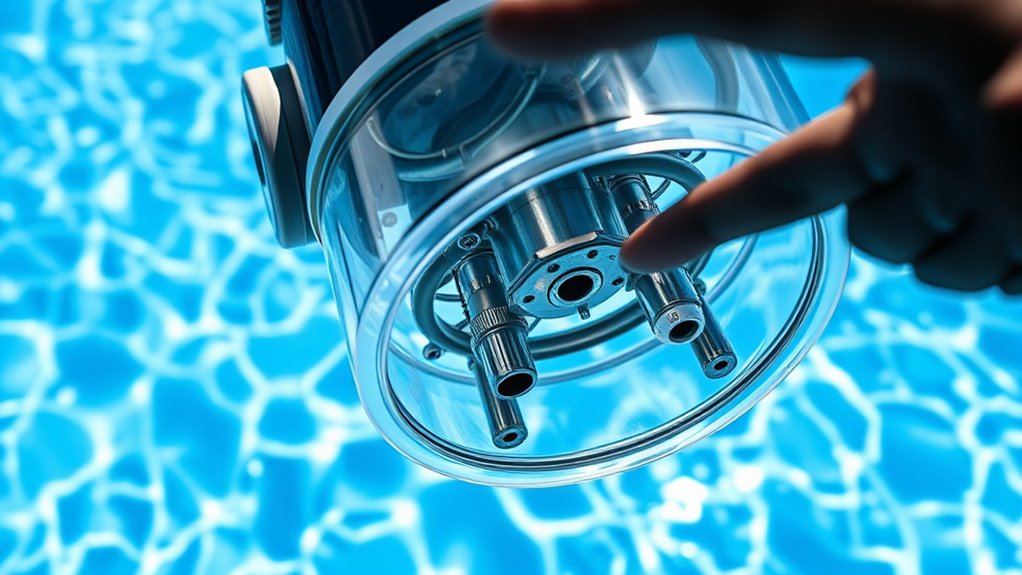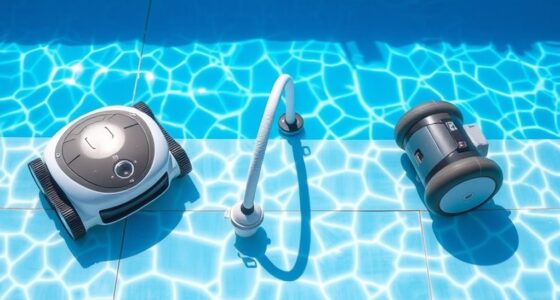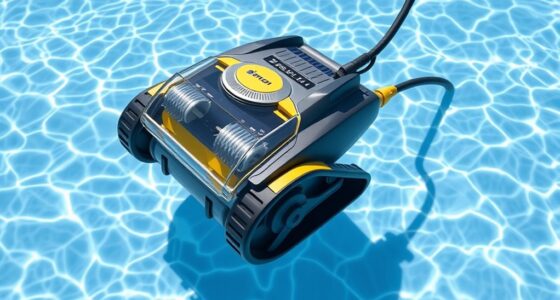If your pressure pool cleaner isn’t working well, start by checking the water flow and pressure—make sure they meet the manufacturer’s specs. Inspect and clean the vacuum hose for blockages or damage, and ensure all connections are tight. Verify the pressure regulator is set correctly and replace any worn or broken parts. Adjust the nozzles and tires if needed, and look for leaks. For more tips to get your cleaner running smoothly, keep going.
Key Takeaways
- Check water flow and pressure to ensure they meet manufacturer specifications, adjusting valves or pump settings as needed.
- Inspect hoses, nozzles, and wheels for blockages, cracks, or leaks, replacing damaged parts promptly.
- Verify all connections are tight, secure, and free of obstructions to prevent leaks and ensure proper movement.
- Adjust the pressure regulator based on pool size and cleaning needs, and monitor for irregular noises or movement.
- Perform regular maintenance on filters, hoses, and parts, cleaning or replacing components to optimize performance.
Checking the Water Flow and Pressure
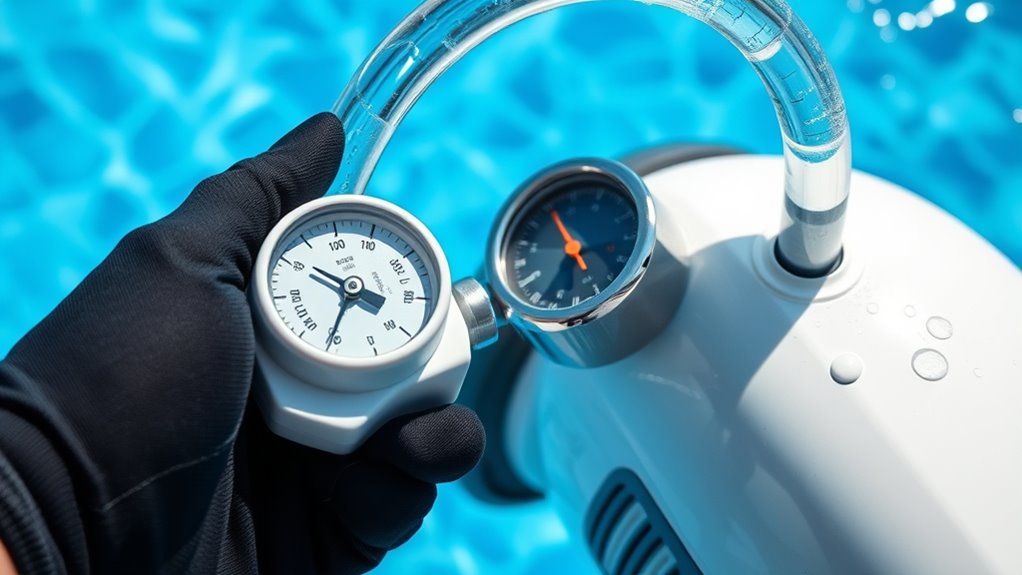
To guarantee your pressure pool cleaner operates effectively, you should start by checking the water flow and pressure. Proper water flow ensures the cleaner moves efficiently, while correct pressure prevents damage. Before making adjustments, review your pool chemistry—imbalances can affect circulation and flow. Always follow safety precautions, such as turning off the pump and unplugging equipment before inspecting components. Use a pressure gauge to verify the pressure level matches the manufacturer’s recommendations. If flow is weak, check for obstructions or clogged filters; if pressure is too high or low, adjust the valve or pump settings accordingly. Maintaining proper water flow and pressure not only enhances cleaning performance but also prolongs your cleaner’s lifespan. Keep safety and pool chemistry in mind throughout this process. Additionally, regularly inspecting sensors and components can help maintain optimal operation and prevent issues. Ensuring your equipment has adequate filtration can also improve overall performance and extend its lifespan. Regularly monitoring and adjusting your system based on pressure readings can help prevent costly repairs. Furthermore, consulting your pressure cleaner’s manual or manufacturer guidelines can provide specific troubleshooting tips tailored to your model.
Inspecting and Cleaning the Vacuum Hose
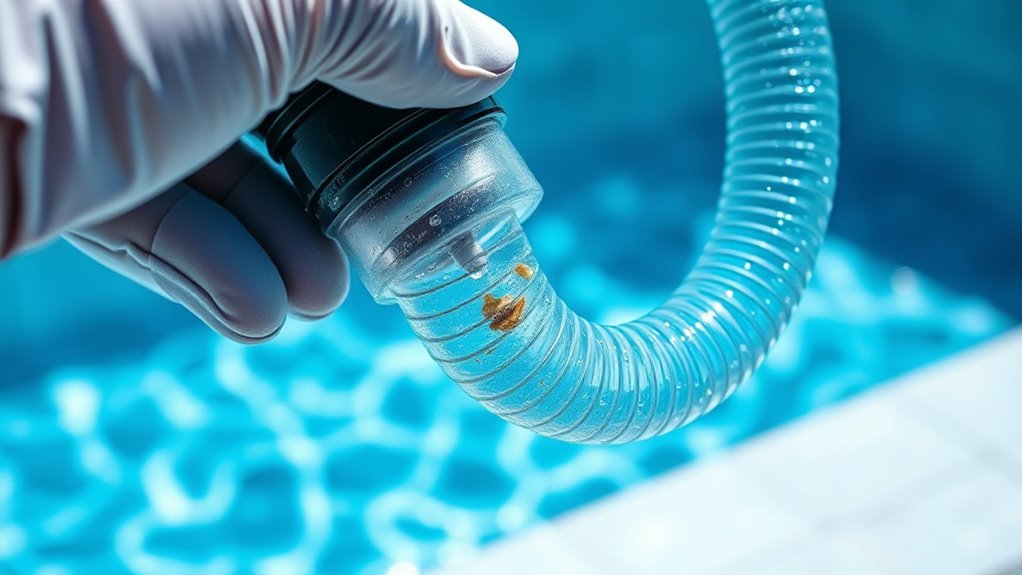
After confirming your pool’s water flow and pressure are within the proper range, it’s time to inspect and clean the vacuum hose. A clogged or debris-filled vacuum hose can hinder cleaning performance. Start by disconnecting the hose from the cleaner and pool. Check for obvious blockages or debris buildup inside. To clean it thoroughly:
- Remove debris by hand or with a hose
- Use a long brush to scrub inside the hose
- Flush with water to clear stubborn debris
- Look for cracks or tears that could cause leaks
- Ensure all connections are secure and free of obstructions
- Regular cleaning is essential to maintain proper suction and prevent issues related to performance cookies and analytics tracking.
Keeping the vacuum hose clear ensures your pressure pool cleaner works efficiently, saving you time and frustration.
Ensuring Proper Installation and Connections
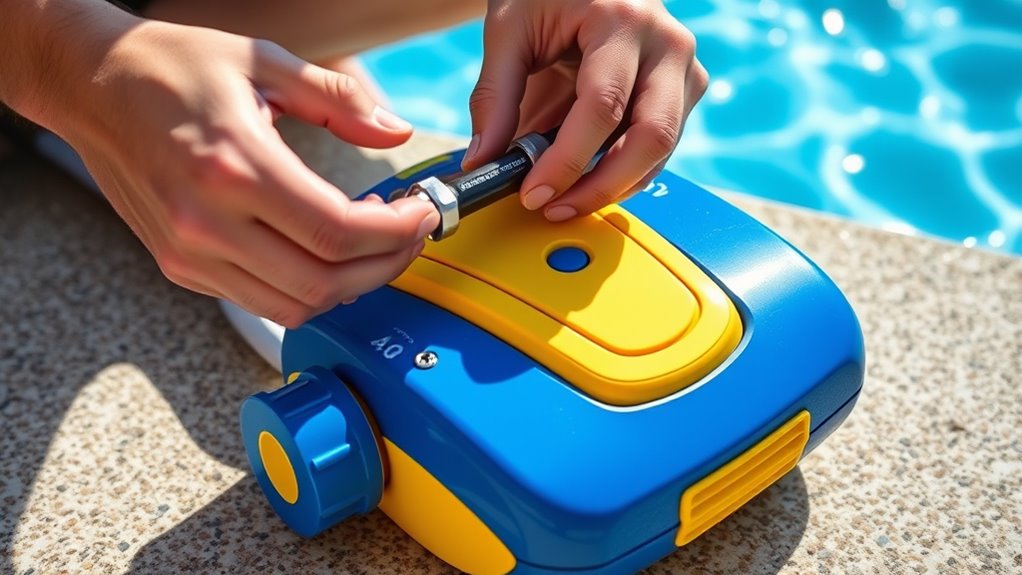
Proper installation and secure connections are essential for your pressure pool cleaner to work efficiently. Start by double-checking that hoses and fittings are tightly connected, preventing leaks that reduce suction power. Make certain your pool’s chemical balance is within the recommended range, as imbalanced chemicals can affect cleaner performance. Also, consider weather impact; extreme temperatures or storms can loosen connections or cause hose degradation. Properly installed equipment minimizes the risk of disconnections during operation. If you notice issues, recheck the connections and tighten as needed. Maintaining a balanced pool chemistry supports optimal cleaner performance, while secure fittings prevent pressure loss. Regular maintenance and careful inspection help ensure your cleaner remains in good working condition. Additionally, inspecting hoses for wear and tear can prevent unexpected failures during operation. Being attentive to environmental factors, such as temperature fluctuations, can also extend the lifespan of your equipment. By paying close attention to installation details and environmental factors, you help ensure your pressure pool cleaner operates smoothly and effectively, especially when considering symptoms of equipment failure that might indicate underlying issues.
Examining the Skimmer and Pump Baskets
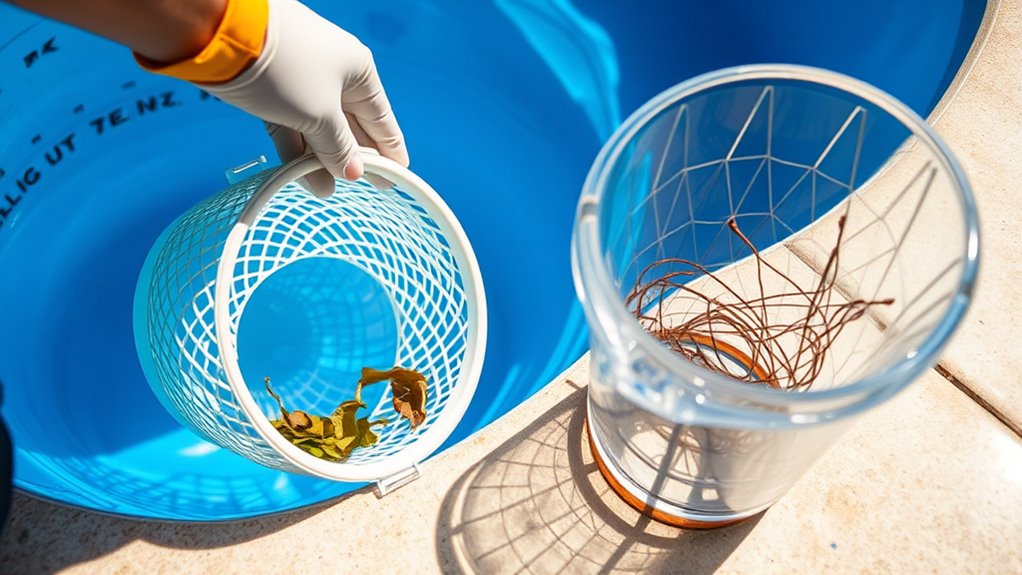
Ensuring your pressure pool cleaner runs smoothly starts with inspecting the skimmer and pump baskets. Start by removing the skimmer basket and checking for debris, leaves, or any blockages that could restrict water flow. Next, examine the pump basket for clogs that might hinder circulation. Keep these baskets clean to maintain ideal pressure and prevent strain on your system. Additionally, regularly inspecting for signs of damage or wear can help prevent unexpected failures and extend the lifespan of your equipment. Proper maintenance of these components is essential for optimal performance and efficient operation. Remember that self watering plant pots can be a helpful analogy for maintaining consistent and healthy water flow in your pool system. Incorporating routine vibrational maintenance can further improve the longevity and efficiency of your pool equipment, just as maintaining plant health requires consistent care.
Verifying the Correct Pressure Regulator Settings
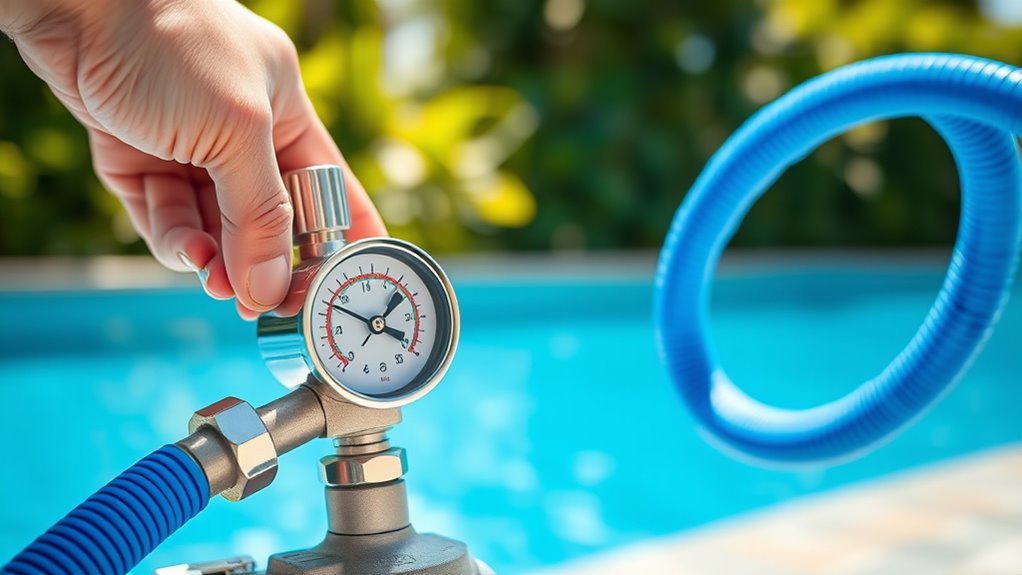
Start by checking the manufacturer’s recommended pressure settings for your pool cleaner. Adjust the regulator based on your pool size and cleaning needs, then test the system to see if performance improves. Making these small changes can markedly enhance your cleaner’s efficiency. Additionally, ensuring the correct pressure regulator settings are maintained can help prevent potential damage to the system over time. Proper pressure regulation also contributes to optimal cleaning performance and longevity of the equipment, especially when considering tuning options for related components. Regularly inspecting and maintaining the system’s pressure can further optimize cleaning results and extend the lifespan of your pool cleaner. Monitoring the system’s efficiency ratings can also help identify opportunities for performance improvements and energy savings.
Check Manufacturer Settings
Since pressure regulator settings can vary by manufacturer, verifying that your pool cleaner’s settings match the specifications provided in the user manual is essential. Making sure the manufacturer settings are correct helps maintain proper system calibration and peak performance. To do this, check the recommended pressure range and compare it with your current setup. Adjustments may be necessary if the system isn’t calibrated properly.
Here are key steps to verify manufacturer settings:
- Consult the user manual for specific pressure recommendations
- Confirm the pressure regulator is set within the suggested range
- Inspect for signs of wear or damage affecting settings
- Reset the regulator if needed, following manufacturer instructions
- Record adjustments to ensure consistent system calibration over time
Adjust Based on Pool Size
Adjusting the pressure regulator based on your pool size helps optimize the cleaner’s performance. Larger pools typically require higher pressure settings to ensure the cleaner covers the entire area effectively. Conversely, smaller pools may need lower pressure to prevent overworking the system. Keep in mind that seasonal adjustments can impact pool chemistry, such as increased debris in fall or algae in summer, which can also influence the ideal pressure. Regularly verify that your pressure regulator matches your pool’s size and current conditions. Proper adjustment helps maintain efficient cleaning and prevents unnecessary wear on the equipment. Additionally, daisy varieties can attract pollinators that may help keep the surrounding area clean and healthy. By tailoring the pressure to your pool size and seasonal changes, you ensure consistent, thorough cleaning without stressing your pool’s components. Monitoring the safety features of your pressure system can further enhance overall operation and safety. Ensuring proper pool maintenance routines can help prevent issues that affect pressure regulation and system performance. Understanding alimony laws can also inform maintenance and safety considerations for your pool equipment. Staying informed about industry trends can help you adapt your pool maintenance practices effectively.
Test After Changes
After making changes to your pressure regulator, it’s essential to verify that the settings are correct to guarantee maximum cleaner performance. Proper pressure ensures your cleaner moves efficiently, maintaining a balanced chemical level and preventing algae buildup. To check, observe the cleaner’s movement and listen for irregular noises. Adjust the regulator if needed, then re-test. Keep in mind:
- Confirm the pressure matches manufacturer recommendations
- Check for consistent movement across all pool areas
- Ensure the cleaner isn’t missing spots or getting stuck
- Verify the pool’s chemical balance remains ideal
- Monitor for algae prevention, especially after pressure adjustments
Performing these steps helps maintain ideal cleaning, reduces chemical imbalances, and prevents algae growth, ensuring your pool stays clean and healthy.
Assessing for Obstructions in the Cleaner’s Path
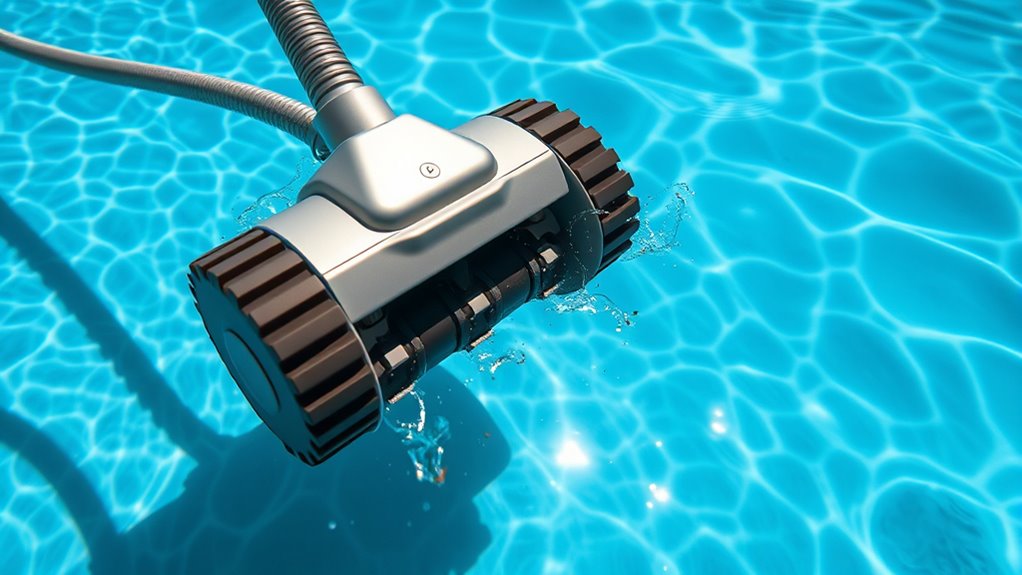
Obstructions in the cleaner’s path are a common cause of performance issues, so it’s important to check for any debris or objects blocking its movement. Start by inspecting the pool’s floor and walls for leaves, toys, or other debris that could hinder the cleaner. Also, consider how chemical balance and pool lighting might affect visibility; poor lighting can hide obstructions, while imbalanced chemicals can cause debris buildup or algae, which may trap the cleaner. Ensure the cleaner’s brushes and intakes are clear of debris too. Regularly checking these areas helps maintain ideal flow and prevents obstructions from slowing down or stopping the cleaner. Keeping the pool well-maintained and well-lit makes it easier to spot and remove any obstructions early.
Replacing Worn or Damaged Parts
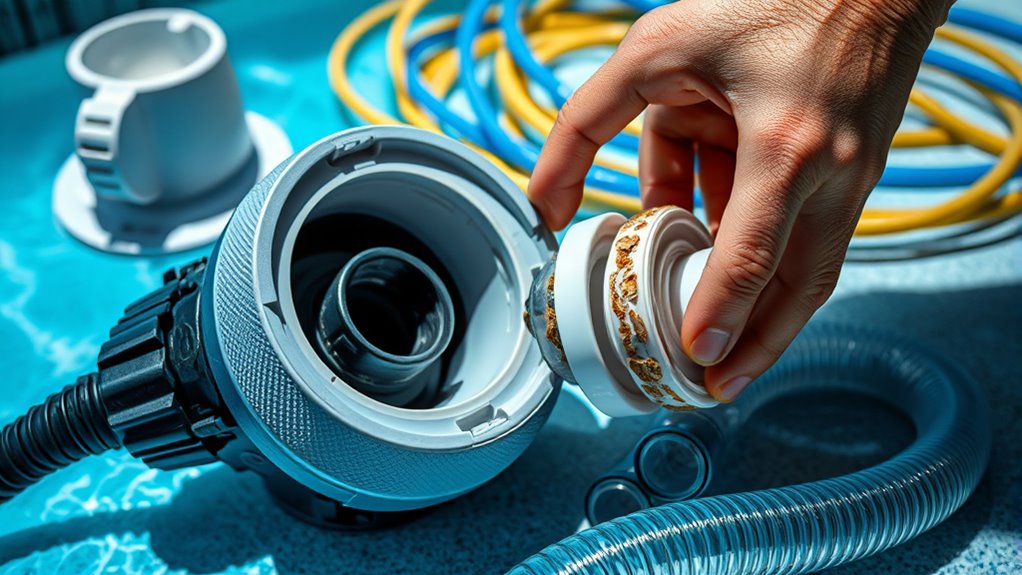
Worn or damaged parts can substantially impact your pool cleaner’s performance, causing it to work inefficiently or stop altogether. Regularly inspecting and replacing these parts guarantees smooth operation. You might need to replace:
- Hoses or hoses connectors that are cracked or leaking
- Nozzles that have worn down, affecting water flow
- Tires or wheels that are cracked or lose grip
- Seals or gaskets that no longer prevent leaks
- Brushes or scrubbers that are frayed or damaged
Keep in mind, maintaining proper pool chemical balance can extend the lifespan of your cleaner parts. Additionally, exploring solar heating options can reduce strain on the cleaner, decreasing wear and tear. Regular upkeep helps keep your pool sparkling and your cleaner running efficiently.
Adjusting the Cleaner’s Nozzle and Tire Pressure
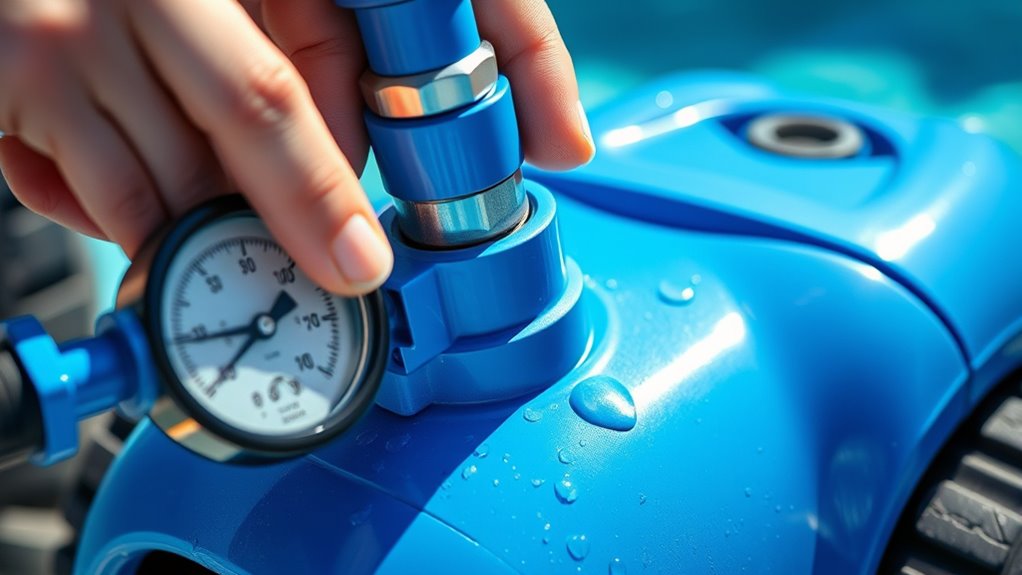
Proper nozzle alignment guarantees your cleaner moves efficiently across the pool floor, so check that it’s pointed straight and unobstructed. Adjusting the tire pressure helps maintain ideal traction and maneuverability; aim for the manufacturer’s recommended levels. Small tweaks to these settings can make a big difference in your cleaner’s performance.
Nozzle Alignment Tips
To maximize your pool cleaner’s performance, start by ensuring the nozzle is properly aligned. Misalignment can cause nozzle misalignment issues or nozzle blockage, reducing cleaning efficiency. Check that the nozzle points directly forward and isn’t tilted or crooked. If you notice uneven cleaning, realign the nozzle carefully. Also, inspect for debris or obstructions that might cause nozzle blockage; cleaning it out can restore proper flow.
Here are some tips:
- Verify the nozzle is straight and facing forward
- Remove any debris blocking the nozzle opening
- Ensure the nozzle isn’t cracked or damaged
- Adjust the nozzle angle for ideal water flow
- Regularly inspect for nozzle misalignment after use
Proper alignment keeps your cleaner running smoothly and prevents unnecessary issues.
Tire Pressure Adjustment
Adjusting the tire pressure on your pool cleaner is essential for ideal performance, especially when it comes to the nozzle and tire operation. Proper tire pressure ensures smooth movement and helps prevent common issues during cleaner troubleshooting. Check the manufacturer’s recommended tire pressure and use a gauge to measure it accurately. If the tires are underinflated, they may cause the cleaner to drag or miss areas; overinflated tires can lead to poor traction or increased wear. Adjust the pressure accordingly by adding or releasing air through the valve stem. Consistently maintaining the correct tire pressure keeps your cleaner running efficiently and extends its lifespan. Regular adjustments also make troubleshooting easier, preventing minor issues from escalating into major problems.
Testing for Leaks in the System
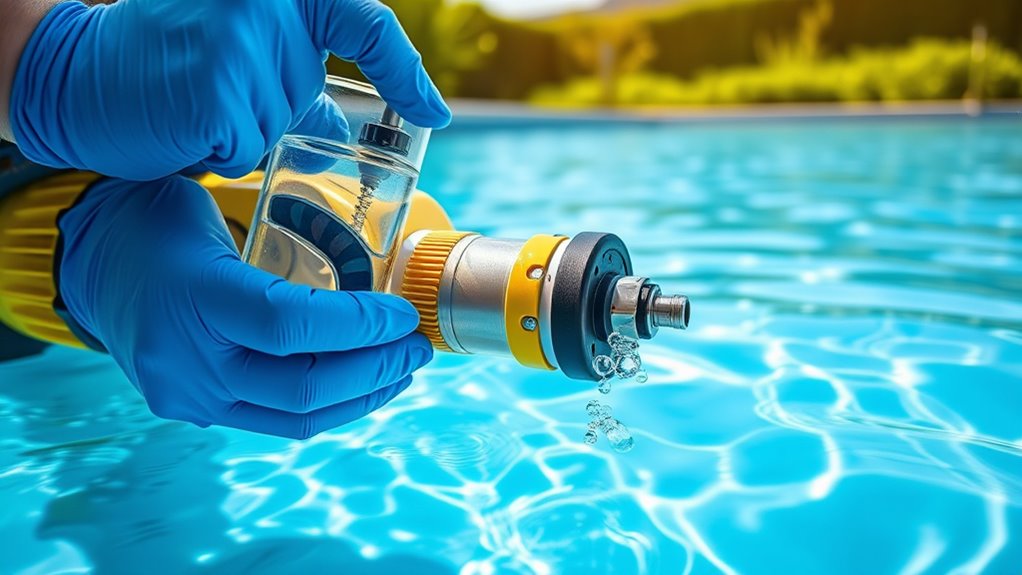
If your pressure pool cleaner isn’t functioning correctly, checking for leaks in the system is a crucial first step. Leaks can disrupt water flow, affecting cleaning performance. Before inspecting, verify your pool water chemistry is balanced and safety precautions are in place. To detect leaks:
- Examine hoses and connections for visible cracks or tears.
- Listen for hissing sounds indicating escaping air or water.
- Submerge parts in water to spot bubbles, revealing leaks.
- Check the pump lid and fittings for tightness.
- Inspect seals and gaskets for damage or wear.
Addressing leaks promptly prevents further damage and maintains ideal pressure. Remember to turn off equipment before inspecting, and always follow safety precautions to avoid injury. Regular leak testing helps keep your cleaner working efficiently.
Maintaining Regular Cleaning and Maintenance Routines
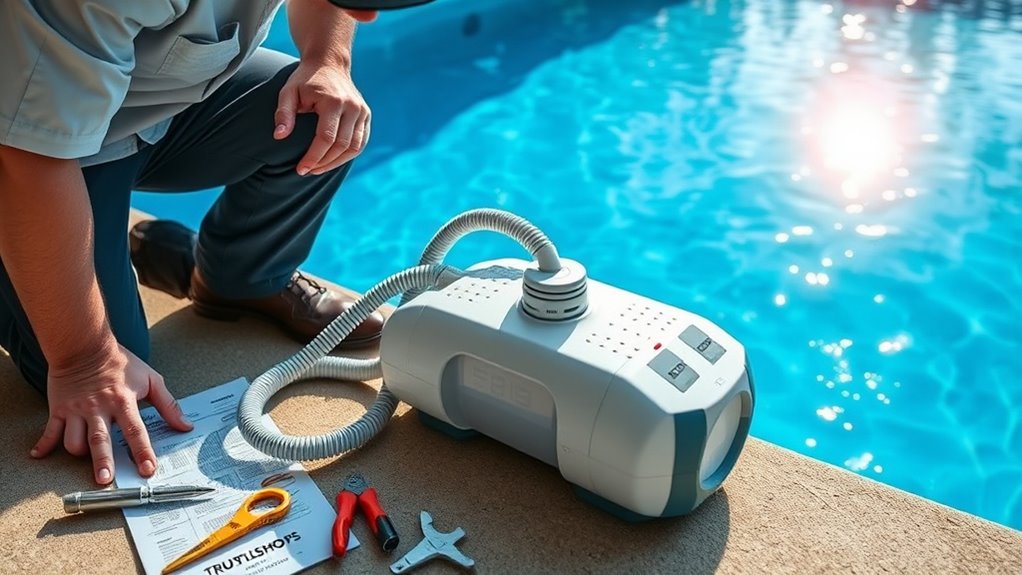
To keep your pressure pool cleaner working smoothly, stick to a regular cleaning schedule. Make sure to inspect parts frequently and replace any that show signs of wear or damage. Consistent maintenance helps prevent bigger issues and keeps your pool spotless.
Scheduled Cleaning Schedule
Have you established a consistent cleaning routine for your pressure pool cleaner? Regular scheduling helps keep your pool in top shape and prevents issues. Set specific days for cleaning to guarantee your equipment stays efficient. During each session, check the pool chemical balance to avoid algae and cloudy water. Incorporate seasonal maintenance, like adjusting cleaning frequency as temperatures change. Keep these tasks in mind:
- Regularly inspect and clean the filter
- Adjust cleaning times based on pool usage
- Monitor water chemistry consistently
- Schedule thorough seasonal maintenance
- Clear debris from pool surfaces
Sticking to a routine prevents buildup and keeps your pressure cleaner running smoothly. Consistent care minimizes breakdowns, saves money, and ensures your pool stays inviting all season long.
Inspect and Replace Parts
Regularly inspecting and replacing parts is essential to keep your pressure pool cleaner functioning efficiently. Over time, wear and tear can cause components like hoses, filters, or brushes to break down. Before inspecting, ensure your pool’s chemical balancing is correct to prevent corrosion or buildup that may damage parts. Check for cracks, clogs, or leaks in hoses and replace them as needed. Clean or replace filters to maintain optimal suction. If your pool uses solar heating options, ensure that any panels or connections are intact and functioning properly, as debris or damage can impair performance. Regular maintenance prevents costly repairs down the line and keeps your cleaner running smoothly, saving you time and effort during routine pool care.
Frequently Asked Questions
How Do I Reset My Pressure Pool Cleaner After a Blockage?
When your pressure pool cleaner faces a blockage, you’ll want to reset it by first turning off the pump. Check the pressure valve and hose connection for any obstructions, then clear them out. Once everything’s free, reconnect the hose securely and open the pressure valve. Turn the pump back on, and your cleaner should resume normal operation. Regular checks help prevent future blockages and keep your pool sparkling.
What Are Signs My Cleaner’S Motor Is Failing?
Your pool cleaner’s motor is the heart of its dance, so when it falters, you notice signs like power loss or strange noises. If it struggles to start, runs unevenly, or stops altogether, motor issues are likely at play. You might also see reduced cleaning performance or the cleaner moving sluggishly. These hints signal that your motor’s rhythm is fading, and it’s time to give it some attention before it completely stalls.
Can Debris Damage the Cleaner’S Internal Components?
Debris accumulation can indeed cause internal damage to your pressure pool cleaner. When debris gets trapped or builds up inside, it can strain the motor and other components, leading to wear and tear. Over time, this internal damage may impair the cleaner’s performance or even cause it to fail. Regularly inspecting and cleaning out debris helps prevent such issues, ensuring your cleaner operates smoothly and lasts longer.
How Often Should I Replace the Cleaner’S Wear Parts?
Did you know that regular maintenance can extend the life of your pool cleaner? For ideal performance, you should follow the recommended wear parts replacement schedule, usually every 1-2 seasons, depending on usage. Keep an eye on components like brushes and seals, and replace wear parts promptly to prevent damage. Staying consistent with your replacement schedule ensures your cleaner works efficiently and lasts longer.
Why Is My Cleaner Not Covering the Entire Pool Surface?
If your cleaner isn’t covering the entire pool surface, it could be due to uneven pool chemical balance or inadequate solar heating. Check that your pool’s pH and chlorine levels are properly balanced, as imbalances can affect the cleaner’s movement. Additionally, ensure your solar heating system is functioning well to maintain consistent water temperature, which helps the cleaner operate efficiently and cover the whole surface thoroughly.
Conclusion
By following these steps, you’ll transform your pool cleaner into a tireless, smooth-moving guardian of your pool. Imagine the sparkling water flowing effortlessly, the cleaner gliding seamlessly along the surface like a whisper of breeze. With attentive checks and timely maintenance, you’ll restore its rhythm, ensuring every corner gleams and every splash is pristine. Keep your system tuned and your pool pristine—your perfect aquatic oasis awaits beneath the shimmering surface.
